Bamboo veneer and bamboo plywood
- HOME
- Bamboo veneer and bamboo plywood
What is veneer and plywood?
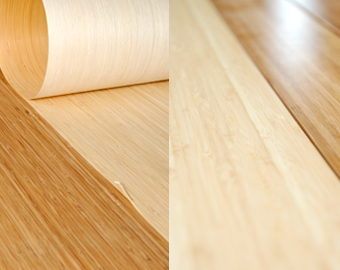
A veneer is a single thin board used for various purposes. However, unlike trees, bamboo never becomes 1m or 2m wide no matter how much it grows. In order to form a plate, many bamboos must be layered and glued through multiple processes. This is called laminated lumber, and in a broader sense, it is also called laminated lumber. This type of veneer is called plywood when it is multi-layered for reasons such as increased strength. Laminated materials are classified into vertical lamination (vertical lamination) and horizontal lamination (horizontal lamination)
according to the direction of the fibers aligned during manufacturing .
*Plywood does not necessarily align the fibers. Thin slices of laminated lumber are called sliced veneers, and sawn boards are sawed by sawing machines.
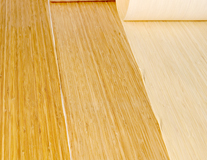
A thin sheet of supple material. Used as a decorative board.
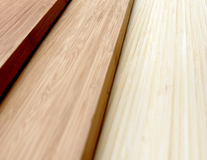
It is a material with a solid wood texture that is thicker and firmer than veneer.
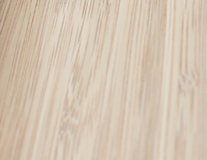
Narrow space between layers for a modern look. How to stack and cut is different.
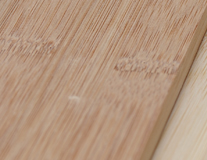
The gap between the layers is wide, and the bamboo joints are an expression. It is also called as Hira Lamination.
bamboo veneer
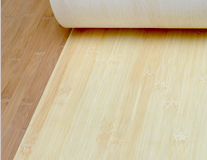
In recent years, it is a finishing material using bamboo, which is a material that is attracting attention. Due to cost and technology issues, we are the only company that manufactures in Japan.
* As of September 2010,we will help you to differentiate yourself from the fact that you cannot get it anywhere else.
Veneer can be used as a surface material for kitchen appliances and furniture, as well as for finishing columns, stiles, ceiling materials, etc.In addition, because of its supple flexibility, it has potential as a material for all industries depending on your ideas.
Usage example of veneer
Furniture surface materials, wall parts and tables, washstands, ceiling materials, etc…
Difference from sawing board
There are many processes with good material efficiency without waste during processing, and the technical requirements are high.

Bamboo veneer standard
| Laminate type | vertical lamination |
|---|---|
| Color variations | light, medium, dark |
| Thickness | 0.25-0.35mm |
| length | 1,800-2,400mm |
| width | 300-320mm |
Bamboo veneer sticking standard
| Laminate type (thickness) |
Vertical lamination (thickness 0.25mm) |
Horizontal lamination (thickness 0.5mm) |
|---|---|---|
| Color variations | light, medium, dark | natural brown |
| length | 6 shaku (approximately 181 cm) to 7 shaku (approximately 212 cm) | )7 shaku (approximately 212 cm) to 8 shaku (approximately 242 cm) |
| width | 3 shaku (about 90 cm) | 4 shaku (about 121cm) |
| Pasting type/Lamination interval | MDF/2.5mm, MDF/4mm | Plywood/2.5mm, Plywood/4mm |
Color variation example





* The base plate and adhesive used are non-formaldehyde (F ☆☆☆☆) is safe.
*These specifications are standard specifications. Please contact us if you are looking for a size not listed here.
bamboo cutting board
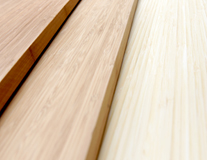
It is a beautiful veneer with bamboo grain.
Not only does it look great, but it also feels luxurious.
It also has excellent dimensional stability and robustness.
Usage example of sawing board
Finishing of pillars, stiles, ceiling materials, etc…
Difference from veneer
Waste such as sawdust is generated during processing.
The surface has a good finish and the texture of solid wood.
Bamboo sawing board standard
| Laminate typ | evertical lamination | horizontal lamination |
|---|---|---|
| Color variations | light, medium, dark | natural brown |
| Thickness | 2 to 19mm | 2 to 8mm |
| length | 1,900-3,700mm | 1,900-2,400mm |
| width | 200mm | |
Color variation example





* The base plate and adhesive used are non-formaldehyde (F) is safe.
* Thickness 19 mm or more can be manufactured by multi-layering.
*Thickness 5mm or more can be manufactured with a width of 200mm or more.
*These specifications are standard specifications. Please contact us if you are looking for a size not listed here.
Conduit material
It is a new material with a unique expression by exposing the bamboo conduit.
The name “Dokanzai” is a product name given by our company for the sake of convenience, and is not a generic name.
Please contact us as this is a made-to-order product.

Bamboo veneer decorative plywood
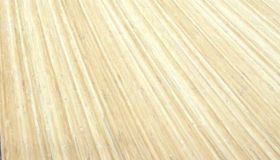
Decorative plywood made from bamboo veneer.
The standard veneer thickness is 0.25 or 0.035 mm.
The standard size is 3×6 to 4×8, but it can be customized to 10 shaku.
MDF and particle board are also available.
Plywood with sawn bamboo board is also available.
Colors (not coloring) are available in 3 colors and can only be applied vertically.
bamboo plywood
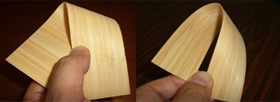
This is a new material bamboo plywood used in the birdman contest.
Originally, bamboo veneer had considerable strength in the vertical direction, but this plywood overcomes the drawback of not being strong in the horizontal direction. By attaching bamboo veneers to vertical and horizontal crosses, it became possible to have strength in the horizontal direction as well.
Depending on the purpose of use, it will be a multi-layer paste of 2 or more layers.
Bamboo laminated solid wood
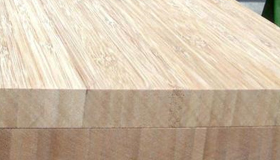
Made of solid laminated bamboo.
Used for stairs, window sills, table tops, etc.
The normal size is 2,400mm x 200mm x 20mm (custom order 3m available).
There are vertical and horizontal attachment. (2.4m for horizontal installation)
There are 3 colors for vertical installation. (Not coloring.)
flexible natural wood veneer Elfart
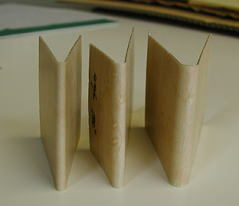
Flexible natural wood veneer Elfart is a natural wood veneer made from bamboo.
This Elfart has more flexibility than the traditional bamboo veneer, enabling more complex three-dimensional molding. Another characteristic of Elfart is its high transparency due to its thinness.
■We make an outstanding performance by natural grain of wood pattern formation to the surface!
Due to its high performance, Elfart can be effectively used for a wide range of products with few restrictions on its use, such as furniture materials, building materials, home appliances, audio equipment, and automobile interior materials.
Please contact us as this is a made-to-order product.
stretches well
It has higher elongation than normal veneer.
This makes it possible to perform three-dimensional molding such as complicated bending and embossing that could not be done with conventional veneer.
high flexibility
It exhibits high flexibility due to its stretchability.
It is resistant to bending and tearing, and can be bent in any direction.
high permeability
It has higher light transmittance than ordinary veneer. More than doubled in each wavelength range.
Also suitable for industrial materials
Elfart’s surface is covered with a polyurethane film, making it extremely slip-resistant and extremely resistant. It also has excellent water resistance, abrasion resistance, and solvent resistance, making it a suitable material for various industrial parts.